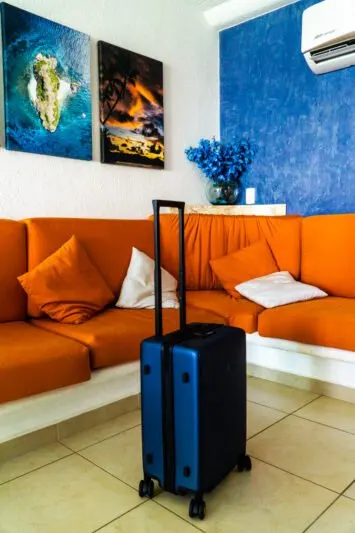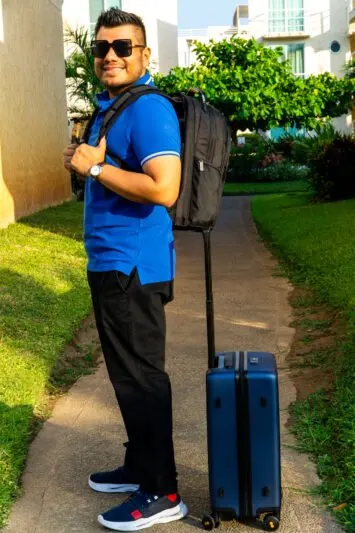Traveling light sounds easy until you try it. One month, one carry-on? Most people pack three times what they need. But traveling with less can save money, time, and stress.
This guide breaks it all down. What to pack, what to skip, and how to make it all fit.
Why Travel With a Carry-On?
Checked bags are a gamble. Airlines lose bags. They charge extra. And they slow you down.
According to the U.S. Department of Transportation, over 680,000 bags were mishandled by U.S. airlines in 2023. That’s about 1 in 100 passengers.
A carry-on skips all that. You walk off the plane and go. No waiting. No lost luggage. No $35 baggage fee.

Step 1: Start With the Right Bag
Size Rules Matter
Most airlines limit carry-ons to around 22 x 14 x 9 inches. Always check the airline’s website. Don’t guess. Some budget airlines are stricter.
Look for a bag that’s soft-sided, has compression straps, and opens like a suitcase. Backpacks are fine too if they fit the size.
Go Lightweight
Your empty bag should weigh no more than 5 to 6 pounds. If it’s heavier, you’re losing space before you even pack.
Step 2: Pack for a Week, Not a Month
This sounds backward. But it works.
No one needs 30 shirts. Pack for 7 days. Do laundry once a week. Almost every city has laundry services or coin-op washers.
This method cuts your packing in half. A traveler named Sean, who spent 3 months in Southeast Asia, said:
“I packed 5 shirts and rotated them. Did laundry every Sunday. Never felt like I was missing anything. Locals dress simple anyway.”
Step 3: Use Packing Cubes
Packing cubes are a cheat code. They keep your stuff organized and compressed. You’ll fit more and stay sane when unpacking.
Label each cube. One for tops. One for bottoms. One for underwear and socks.
You’ll spend less time digging through your bag. Everything has a place.
Step 4: Stick to Neutral Colors
Choose clothes that match everything. Black, gray, navy, beige. Leave the wild prints at home.
If every shirt matches every pair of pants, you can make more outfits with fewer items.
Add one accent piece if you want, like a bright scarf or patterned shirt. That’s enough to keep things interesting.
Step 5: Cut Your Toiletries in Half
You don’t need a full bottle of shampoo. Buy small refillable bottles. Stick to solid versions when possible, like shampoo bars and toothpaste tablets.
Airports have limits. TSA rules say 3.4 ounces or less per item in a quart-size bag.
Most hotels and hostels provide basics like soap. You won’t be camping in the woods.
Step 6: Wear Your Bulkiest Items
Big shoes? Jacket? Wear them on the plane.
You save space in your bag and stay warm on the flight. Planes are cold anyway.
If you’re going somewhere with changing weather, layer. T-shirt, long sleeve, hoodie. You adjust as needed.
What to Pack (and How Much)
Here’s a list that works for most people:
Clothes:
- 4 to 5 shirts
- 2 to 3 pants or shorts
- 1 dress or skirt (optional)
- 1 hoodie or sweater
- 1 lightweight jacket
- 7 pairs of underwear
- 4 to 5 pairs of socks
- 1 pair of sandals or flip-flops
- 1 pair of sneakers or walking shoes
Other items:
- Toiletries in travel bottles
- Phone and charger
- Small power bank
- Passport and travel documents
- Sunglasses
- Reusable water bottle
- Compact laundry bag
- Tiny first-aid kit
That’s it. Don’t add more unless you remove something else.
Step 7: Do Laundry on the Road
You don’t need a washer. A sink and a travel-size detergent pack work fine.
Fill the sink, soak, scrub, rinse, hang. Takes 15 minutes.
Or use laundromats. In most cities, $5 to $8 gets you a wash and dry.
There’s also laundry services. Drop off, pick up next day. In Bangkok, a full load costs about $3.
Step 8: Use Compression for Extras
Compression bags squeeze out air. Great for jackets, sweaters, and anything fluffy.
You sit or roll the air out. No vacuum needed.
Don’t overdo it though. Just because it fits doesn’t mean you should bring it.
Step 9: Skip What You’ll Find There
Don’t bring towels unless you’re going remote. Hostels, hotels, and rentals usually provide them.
Don’t pack guidebooks. Use your phone.
Don’t bring “just in case” items. If you end up needing something, buy it on the road.
Most countries have stores.
Real-World Tip: Ship Stuff Ahead
If you absolutely need bulky gear later in your trip, mail it ahead.
This is common with hikers or people doing multi-season trips. You carry light now, pick up gear later.
It’s like trying to remove negative news articles from Google Search. Sometimes the solution isn’t to carry it all at once, but to deal with it strategically along the way.
Step 10: Use a Simple Checklist
Before each trip, use the same packing list. Save it in your phone. Check it every time.
This stops last-minute stress and overpacking. Travelers often say they bring less each trip because they realize how little they really need.
Alex, who backpacked through South America, said:
“By month two, I mailed a third of my stuff home. The lighter I traveled, the better the trip got.”
Final Thoughts
Traveling for a month with just a carry-on is totally doable. It takes planning and practice. But once you do it, you won’t go back.
You’ll move faster. Spend less. Stress less.
Start with less, keep it simple, and trust that you can handle what comes. The freedom is worth it.

